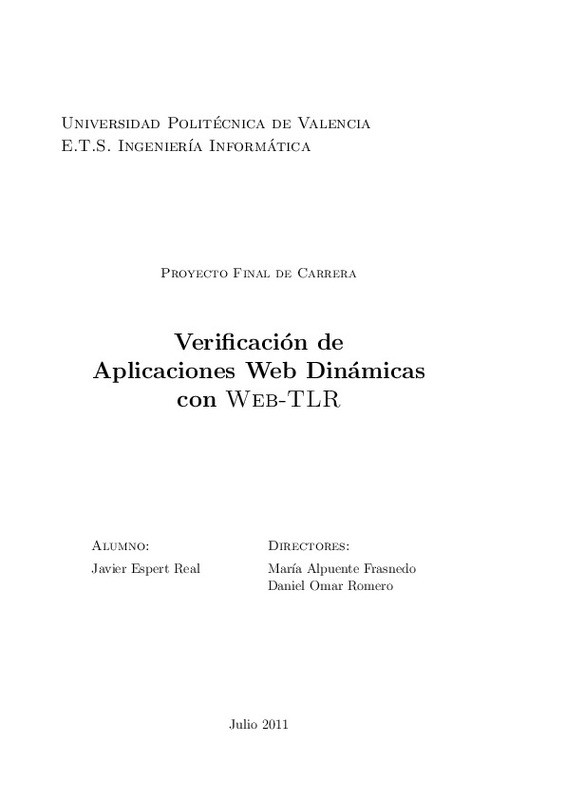JavaScript is disabled for your browser. Some features of this site may not work without it.
Buscar en RiuNet
Listar
Mi cuenta
Estadísticas
Ayuda RiuNet
Admin. UPV
Verificación de aplicaciones web dinámicas con Web-TLR
Mostrar el registro sencillo del ítem
Ficheros en el ítem
| dc.contributor.advisor | Alpuente Frasnedo, María
|
es_ES |
| dc.contributor.author | Espert Real, Javier
|
es_ES |
| dc.date.accessioned | 2011-07-20T11:23:02Z | |
| dc.date.available | 2011-07-20T11:23:02Z | |
| dc.date.created | 2011-07-13 | |
| dc.date.issued | 2011-07-20 | |
| dc.identifier.uri | http://hdl.handle.net/10251/11219 | |
| dc.description.abstract | Web-TLR is a software tool designed for model-checking Web applications that is based on rewriting logic. Web applications are expressed as rewrite theories that can be formally verified by using the Maude built-in LTLR model-checker. Whenever a property is refuted, it produces a counterexample trace that underlies the failing model checking computation. However, the analysis (or even the simple inspection) of large counterexamples may prove to be unfeasible due to the size and complexity of the traces under examination. This work aims to improve the understandability of the counterexamples generated by Web-TLR by developing an integrated framework for debugging Web applications that integrates a trace-slicing technique for rewriting logic theories that is particularly tailored to Web-TLR. The verification environment is also provided with a user-friendly, graphical Web interface that shields the user from unnecessary information. Trace slicing is a widely used technique for execution trace analysis that is effectively used in program debugging, analysis and comprehension. Our trace slicing technique allows us to systematically trace back rewrite sequences modulo equational axioms (such as associativity and commutativity) by means of an algorithm that dynamically simpli es the traces by detecting control and data dependencies, and dropping useless data that do not infuence the final result. Our methodology is particularly suitable for analyzing complex, textually-large system computations such as those delivered as counter-example traces by Maude model-checkers. The slicing facility implemented in Web-TLR allows the user to select the pieces of information that she is interested into by means of a suitable pattern-matching language supported by wildcards. The selected information is then traced back through inverse rewrite sequences. The slicing process drastically simpli es the computation trace by dropping useless data that do not influence the nal result. By using this facility, the Web engineer can focus on the relevant fragments of the failing application, which greatly reduces the manual debugging e ort and also decreases the number of iterative verfications. | es_ES |
| dc.format.extent | 88 | es_ES |
| dc.language | Inglés | es_ES |
| dc.publisher | Universitat Politècnica de València | es_ES |
| dc.rights | Reserva de todos los derechos | es_ES |
| dc.subject | Model checking | es_ES |
| dc.subject | Trace slicing | es_ES |
| dc.subject | Web verification | es_ES |
| dc.subject | Rewriting logic | es_ES |
| dc.subject | Counterexample generation | es_ES |
| dc.subject | Linear temporal logic of rewriting | es_ES |
| dc.subject | Web debugging | es_ES |
| dc.subject.other | Ingeniería Informática-Enginyeria Informàtica | es_ES |
| dc.title | Verificación de aplicaciones web dinámicas con Web-TLR | es_ES |
| dc.type | Proyecto/Trabajo fin de carrera/grado | es_ES |
| dc.rights.accessRights | Abierto | es_ES |
| dc.contributor.affiliation | Universitat Politècnica de València. Escola Tècnica Superior d'Enginyeria Informàtica | es_ES |
| dc.description.bibliographicCitation | Espert Real, J. (2011). Verificación de aplicaciones web dinámicas con Web-TLR. http://hdl.handle.net/10251/11219. | es_ES |
| dc.description.accrualMethod | Archivo delegado | es_ES |
Este ítem aparece en la(s) siguiente(s) colección(ones)
-
ETSINF - Trabajos académicos [5160]
Escola Tècnica Superior d'Enginyeria Informàtica






